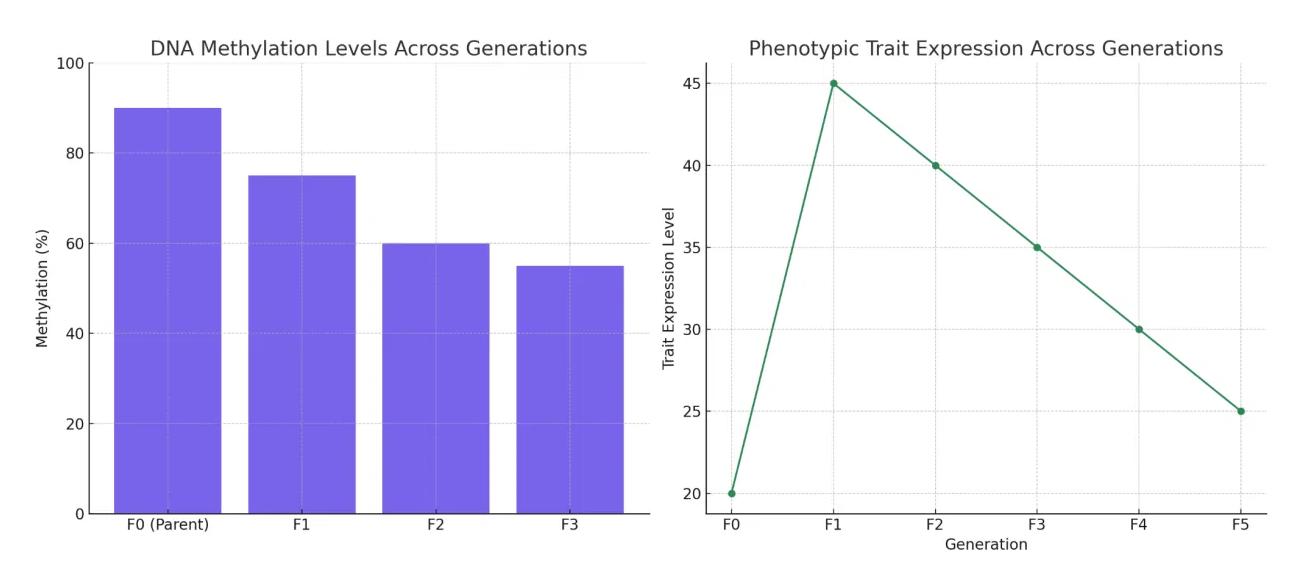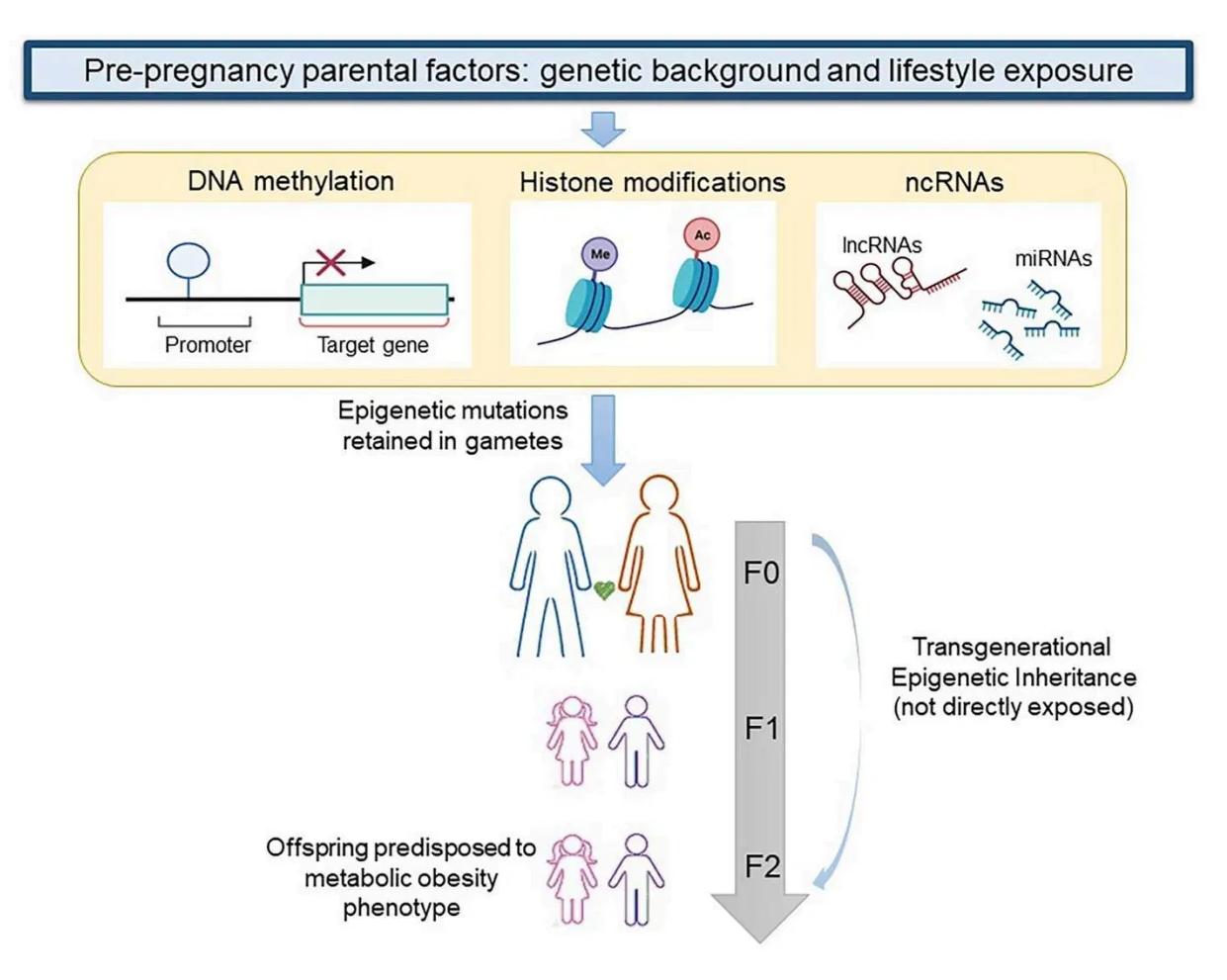Practice D2.2 Gene expression (HL) with authentic IB Biology exam questions for both SL and HL students. This question bank mirrors Paper 1A, 1B, 2 structure, covering key topics like cell biology, genetics, and ecology. Get instant solutions, detailed explanations, and build exam confidence with questions in the style of IB examiners.
What does transcription allow a cell to do?
Transcription is considered a key control point in gene expression. Which of the following statements explains why?
In the image below, the left panel shows changes in global DNA methylation levels (%) in somatic cells over three generations (F0 to F3) following an environmental stimulus in the F0 generation. The right panel displays the expression level of a phenotypic trait over six generations (F0 to F5), highlighting how the phenotype changes across generations despite no changes in the DNA sequence.

State the trend in DNA methylation observed from F0 to F3.
Based on the right graph, identify the generation in which the phenotypic trait expression peaks. Suggest a possible epigenetic explanation for this change.
Explain how DNA methylation can be involved in the heritable silencing of gene expression.
Describe how epigenetic changes, such as those shown here, can contribute to phenotypic plasticity without altering the DNA sequence.
Figure showing transcriptional requlation of qene A in a eukaryotic cell. DNA bending proteins, transcription factors, mediator proteins, and activators interact with RNA polymerase and control elements to initiate transcription.

State the function of the promoter shown in the Figure.
Explain the role of transcription factors and mediator proteins in this diagram.
Describe how the enhancer and its associated proteins regulate the transcription of gene A.
Suggest one reason why this regulatory mechanism allows differential gene expression in different cell types.
The figure shows how pre-pregnancy parental factors, such as genetic background and lifestyle exposures (e.g., diet, stress, pollutants) can lead to epigenetic modifications - including DNA methylation, histone modification, and changes in non-coding RNAs - in germ cells (sperm or egg) of the F0 generation. These epigenetic tags are retained during meiosis, meaning they can be passed to offspring (F1) and even the second generation (F2), creating transgenerational epigenetic inheritance without changes to the underlying DNA sequence.

Recent research compared methylation patterns in families exposed to high air pollution (Group A) and low pollution (Group B). Table 1 summarizes the frequency of methylated promoter regions detected in blood cells of children (F1 generation).
Table: Frequency of promoter methylation in F1 children from exposed vs. unexposed families
| Group | Sample Size (n) | % of Genes With Methylated Promoters |
|---|---|---|
| High Pollution (A) | 30 | 45% |
| Low Pollution (B) | 30 | 20% |
Calculate the difference in promoter methylation between Group A and Group B using Table.
Using Figure, explain how histone modifications can contribute to transgenerational inheritance without changing the DNA sequence.
Identify one phenotypic effect that increased promoter methylation in Group A children might have on cellular function.
Explain why F2 is the first generation classified as "transgenerational epigenetic inheritance" in this system, as shown in Figure.
State one environmental example (besides air pollution) that could alter epigenetic tags, and describe its potential effect on gene expression.
Figure a shows a schematic of the CRISPR-Cas9 system and outcomes of double-strand DNA break repair by either homology-directed repair (HDR) or nonhomologous end joining (NHEJ).

Figure b illustrates early stages of embryonic development and epigenetic regulation during the maternal-to-zygotic transition (MZT).

Using Figure a), identify two molecular components required for Cas9 to recognize and cut DNA.
Compare the two DNA repair mechanisms (HDR and NHEJ) shown in Figure a), and explain how each can result in different outcomes for the cell.
Describe the significance of the zygotic genome activation (ZGA) shown in Figure b), and when it occurs during embryo development.
Discuss how DNA methylation changes shown in Figure b) influence gene expression between the pre-implantation and post-implantation stages.
Suggest one way the CRISPR-Cas9 system could be used to study gene function during embryonic development.
The number of protein-coding genes in the human genome is estimated to be about 20000 , which is much less than the size of the proteome. What is one reason for this?
Define epigenesis and epigenome, and briefly describe their significance in multicellular organisms.
Describe how methylation of the promoter region in DNA impacts gene expression.
Outline one example of environmental effects on gene expression, including the mechanism by which this occurs.
Define genotype, phenotype, and gene expression.
List two stages in the process of gene expression.
Explain the regulation of transcription by transcription factors that bind to the promoter sequence of DNA.